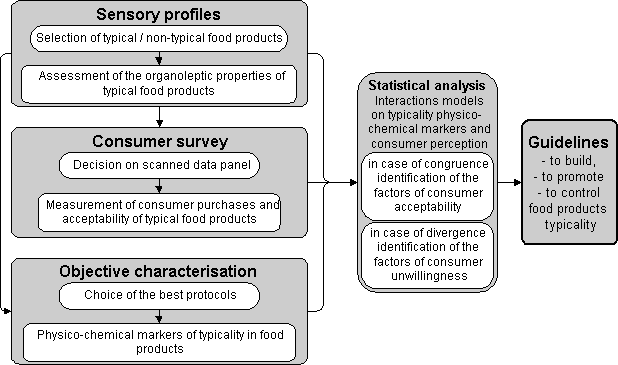 |
 |
 |
 |
 |
 |
 |
 |
© 2003
TYPIC Public conference
More Information
Contents
Within the TYPIC project nine research partners and eight subcontractors will work on four work-packages.
Work-Package 1 aims at selecting typical food products (dry-cured hams and red wines, under origin-labelling and other labels across the EU) and to assess their organoleptic properties.
Work-Package 2 will measure consumer purchase and acceptability of typical food products. This will focus on consumers' preferences for typical food products and on their actual buying behaviour.
Work-Package 3 will characterise physico-chemical traits of typicality. This aims at analysing on a few selected products, physico-chemical properties that could help provide objective bases for typicality.
Work-Package 4 will propose guidlines to build, to control and to promote typicality. The final Work-Package (WP) will combine all analyses and establish relationships between them. Guidelines to improve the reliability of typical food products claims, for both consumers and producers but also for the rest of the agro-food chain, will be based on the conclusions presented in the other Work-Packages.
See 'Work Plan' for more information.
Work Plan

Workpackage 1
Assessment of the organoleptic properties of typical food products
Task 1 Selection of typical / non typical food products :
- 30 wines Beaujolais (France)
- 30 wines Dornfelder (Germany)
- 20 dry-cured hams (France)
- 20 dry-cured hams (Spain)
Task 2 Definition of attributes qualifying the typical food products (focus group discussions with food chain actors)
Task 3 Sensory profile analysis by trained panel
Workpackage 2
Measurement of consumer purchase and acceptability of typical food products
Task 4 Measurement of actual purchase of typical food products with consumer scanned data panel
- 1600 panellists
Task 5 Consumer hedonist tests
- 800 consumers
Task 6 Trade-off measurement of main expected attributes of typicality
- 400 consumers
Workpackage 3
Physico-chemical characterisation of typicality
Task 7 Chromatographic methods to authenticate and assess typicality
- High Performance Liquid Chromatography
- High Resolution Gas Chromatography
- Polyacrylamide Gel Electrophoresis
Task 8 Physical methods to authenticate and assess typicality
- High Resolution Nuclear Magnetic Resonance
- Electrospray Ionisation Mass Spectrometry
- Front-face Fluorescence Spectroscopy
- Fourier-Transform Infrared and FT-Raman Spectroscopy
- Mechanical test methods
Task 9 Data processing and discrimination between typical and
non-typical food products
Workpackage 4
Guidelines to build, to promote and to control typicality
Task 10 Identification of the technological factors underlying typicality of dry-cured ham and red wine
Task 11 Identification of the relationships between objective characters and consumer perception
Task 12 Translation into guidelines to build, to control and to
promote typicality